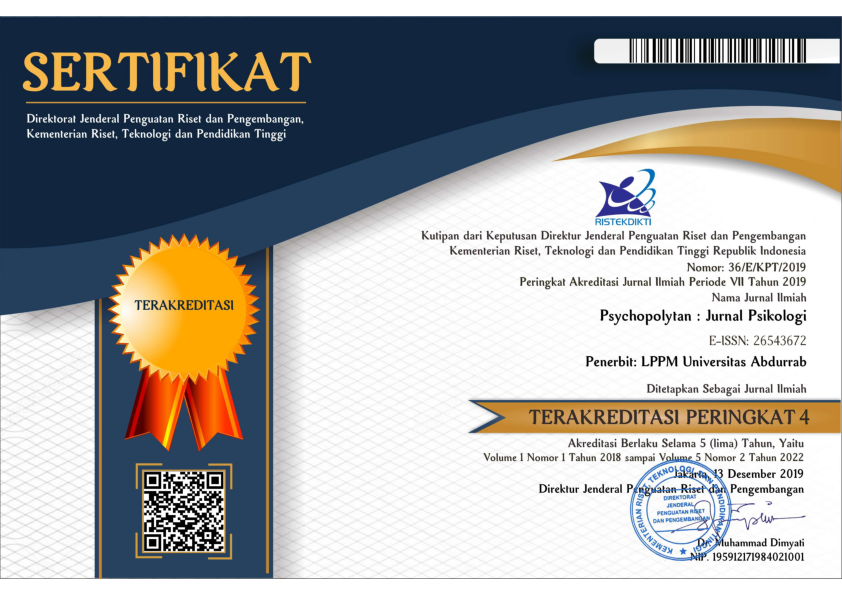Strategi Koping Remaja Mengatasi Kesepian
Abstract
Loneliness is a mental health issue. The aim of this research is to understand how adolescents recognize, feel and overcome loneliness. The research was conducted using a descriptive qualitative approach, involving 38 adolescent (21 girls and 17 boys) who experienced loneliness in three junior high schools (SMP) in Pekanbaru. The data was obtained through online interviews using Google Form. Data analysis uses thematic analysis techniques. The results showed that junior high school adolescents used various coping strategies to overcome loneliness. The most commonly used strategy in grades 8 and 9 is focusing on emotions, while in grade 7 focuses more on problems. The results of this research provide an overview of loneliness and how to overcome it from an adolescent perspective so that it can help the process of counseling and therapy for loneliness in adolescents. Further research is needed to understand the factors that influence adolescents' coping strategies in overcoming loneliness.
References
Agriyanti, S. M., & Rahmasari, D. (2021). Perbedaan Tingkat Kesepian pada Siswa Kelas X dan XI Ditinjau dari Efektivitas Komunikasi Orangtua. Jurnal Penelitian Psikologi, 8(5), 181–188.
Balážová, M., Gallová, I., Praško, J., Šlepecký, M., & Kotianová, A. (2017). Family environment as predictor of adolescents’ loneliness. European Psychiatry, 41(1), 6–11. https://doi.org/10.1016/j.eurpsy.2017.01.259
Barber, B. K., & Olsen, J. A. (2004). Assessing the Transitions to Middle and High School. Journal of Adolescent Research, 19(1), 3–30. https://doi.org/10.1177/074355840325811
Baron, R. A., & Byrne, D. (2005). Psikologi Sosial. Jakarta: Erlangga
Bonetti, L., Campbell, M. A., & Gilmore, L. (2010). The relationship of loneliness and social anxiety with children’s and adolescents’ online communication. Cyberpsychology, Behavior, and Social Networking, 13(3), 279–285. https://doi.org/10.1089/cyber.2009.0215
Bozorgpour, F., & Salimi, A. (2012). State Self-Esteem, Loneliness and Life Satisfaction. Procedia - Social and Behavioral Sciences, 69, 2004–2008. https://doi.org/10.1016/j.sbspro.2012.12.157
Chen, H., Levkoff, S. E., Kort, H., McCollum, Q. A., & Ory, M. G. (2023). Editorial: Technological innovations to address social isolation and loneliness in older adults. Frontiers in Public Health, 11. https://doi.org/10.3389/fpubh.2023.1139266
Co, D. (2014). The European Proceedings of Social & Behavioural Sciences eISSN : 2357-1330 An Evaluation of Loneliness. 73.
Dafnaz, H. K., & Effendy, E. (2020). Hubungan Kesepian dengan Masalah Psikologis dan Gejala Gangguan Somatis pada Remaja. SCRIPTA SCORE Scientific Medical Journal, 2(1), 6–13. https://doi.org/10.32734/scripta.v2i1.3372
Deckx, L., van den Akker, M., Buntinx, F., & van Driel, M. (2018). A systematic literature review on the association between loneliness and coping strategies. Psychology, Health and Medicine, 23(8), 899–916. https://doi.org/10.1080/13548506.2018.1446096
Fajrian. (2021). Survei: 98 Persen Orang Indonesia Kesepian di Masa Pandemi. CnnIndonesia.Com. https://www.cnnindonesia.com/gaya-hidup/20210813160739-284-680076/survei-98-persen-orang-indonesia-kesepian-di-masa-pandemi
Febriani, Z. (2021). Perbedaan Tingkat Kesepian Pada Remaja Ditinjau Dari Jenis Kelamin. Pendidikan Tambusai, 5(3), 7032–7037.
Franssen, T., Stijnen, M., Hamers, F., & Schneider, F. (2020). Age differences in demographic, social, and health-related factors associated with loneliness across the adult life span. (19–65 years): A cross-sectional study in the Netherlands. BMC Public Health, 20(1), 1118. https://doi.org/10.1186/s12889-020-09208-0
Gierveld, J. de J., van Tilburg, T., & Dykstra, P. A. (2009). Loneliness and Social Isolation. The Cambridge Handbook of Personal Relationships, May 2014, 485–500. https://doi.org/10.1017/cbo9780511606632.027
Gu, S., He, Z., Sun, L., Jiang, Y., Xu, M., Feng, G., Ma, X., Wang, F., & Huang, J. H. (2021). Effects of Coronavirus-19 Induced Loneliness on Mental Health: Sleep Quality and Intolerance for Uncertainty as Mediators. Frontiers in Psychiatry, 12(September), 1–10. https://doi.org/10.3389/fpsyt.2021.738003
Hards, E., Loades, M. E., Higson-Sweeney, N., Shafran, R., Serafimova, T., Brigden, A., Reynolds, S., Crawley, E., Chatburn, E., Linney, C., McManus, M., & Borwick, C. (2021). Loneliness and mental health in children and adolescents with pre-existing mental health problems: A rapid systematic review. British Journal of Clinical Psychology, 1–22. https://doi.org/10.1111/bjc.12331
Hawkley, L. C., & Cacioppo, J. T. (2010). Loneliness matters: A theoretical and empirical review of consequences and mechanisms. Annals of Behavioral Medicine, 40(2), 218–227. https://doi.org/10.1007/s12160-010-9210-8
Hemberg, J., Korzhina, Y., Groundstroem, H., Östman, L., Nyström, L., & Nyman-Kurkiala, P. (2021). Loneliness – two sides to the story: Adolescents’ lived experiences. International Journal of Adolescence and Youth, 26(1), 41–56. https://doi. org/10.1080/02673843.2021.1883075
Khatami, M., Nadzifah, N., & Yundianto, D. (2021). About Closeness and Malicious Intent: Role of Loneliness with Emotional intimacy to Malicious envy/ Tentang Kedekatan dan Niat Jahat: Peran Kesepian dengan Kelekatan Emosional Terhadap Iri Hati. Psikoislamika : Jurnal Psikologi Dan Psikologi Islam, 18(1), 163–173. https://doi.org/10.18860/psikoislamika.v18i1.12120
Kholidah, E., & Alsa, a. (2012). Berpikir Positif untuk Menurunkan Stres Psikologis. Jurnal Psikologi, 39(1), 67–75. http://jurnal.psikologi.ugm.ac.id/index.php/fpsi/article/view/180
Kristlyna, E., & Sudagijono, J. S. (2020). Jurnal Experentia Volume 8, Nomor 2, Desember 2020. Jurnal Experentia, 8(2), 104–111.
Lazarus, R. S., & Folkman, S. (1984). Stress, appraisal, and coping.
Maryam, S. (2017). Strategi Coping. Jurnal Konseling Andi Matappa, 1(2), 101.
Maschi, T., Viola, D., Morgen, K., & Koskinen, L. (2015). Trauma, stress, grief, loss, and separation among older adults in prison: The protective role of coping resources on physical and mental well-being. Journal of Crime and Justice, 38(1), 113–136. https://doi.org/10.1080/0735648X.2013.808853
Matthews, T., Danese, A., Caspi, A., Fisher, H. L., Goldman-Mellor, S., Kepa, A., Moffitt, T. E., Odgers, C. L., & Arseneault, L. (2019). Lonely young adults in modern Britain: Findings from an epidemiological cohort study. Psychological Medicine, 49(2), 268–277. https://doi.org/10.1017/S0033291718000788
McCauley, R. N. (2021). Smartphones, Social Media, and Adolescent Loneliness Does the use of smartphones and social media induce loneliness? Www.Psychologytoday.Com. https://www.psychologytoday.com/intl/blog/why-religion-is-natural-and-science-is-not/202108/smartphones-social-media-and-adolescent
Moleong, Lexy J. (2017). Metode Penelitian Kualitatif, Cetakan Ke-36. Bandung: PT. Remaja Rosdakarya Offset
Mushtaq, R., Shoib, S., Shah, T., & Mushtaq, S. (2014). Relationship between loneliness, Psychiatric disorders and physical health ? A review on the psychological aspects of loneliness. Journal of Clinical and Diagnostic Research, 8(9), WE01–WE04. https://doi.org/10.7860/JCDR/2014/10077.4828
Nurdiani, A. F., & Mulyono, R. (2019). Pengaruh dukungan sosial dan attachment style terhadap perasaan kesepian pada remaja yang tinggal di panti asuhan khazanah kebajikan. TAZKIYA: Journal of Psychology, 2(2). https://doi.org/10.15408/tazkiya.v2i2.10769
Nurhidayah, S., Ekasari, A., Muslimah, A. I., Pramintari, R. D., & Hidayanti, A. (2021). Dukungan Sosial, Strategi Koping Terhadap Resiliensi Serta Dampaknya Pada Kesejahteraan Psikologis Remaja Yang Orangtuanya Bercerai. Paradigma, 18(1), 60–77. https://doi.org/10.33558/paradigma.v18i1.2674
Pratiwi, D., Dahlan, T. H. D., & Damaianti, L. F. (2019). Pengaruh Self-Compassion Terhadap Kesepian Pada. 3(2), 88–97.
Qualter, P., Brown, S. L., Rotenberg, K. J., Vanhalst, J., Harris, R. A., Goossens, L., Bangee, M., & Munn, P. (2013). Trajectories of loneliness during childhood and adolescence: Predictors and health outcomes. Journal of Adolescence, 36(6), 1283–1293. https://doi.org/10.1016/j.adolescence.2013.01.005
Rokach, A. (2018). Effective Coping with Loneliness: A Review. Open Journal of Depression, 07(04), 61–72. https://doi.org/10.4236/ojd.2018.74005
Russell, D. W. (1996). UCLA Loneliness Scale (Version 3): Reliability, Validity, and Factor Structure. Journal of Personality Assessment, 66(1), 20–40. https://doi.org/10.1080/00223891.1972.10119803
Russell, D. W., Cutrona, C. E., McRae, C., & Gomez, M. (2012). Is loneliness the same as being alone? Journal of Psychology: Interdisciplinary and Applied, 146(1–2), 7–22. https://doi.org/10.1080/00223980.2011.589414
Sagita, D. D., & Hermawan, D. (2020). Kesepian Remaja Pada Masa Pandemi COVID-19. ENLIGHTEN (Jurnal Bimbingan Dan Konseling Islam), 3(2), 122–130. https://doi.org/10.32505/enlighten.v3i2.1892
Saputra, M. A., Cahyani, E., Alzuhra, N., & Syaputra, Y. (2020). Gambaran Respon Emosi dan Strategi Koping Masyarakat terhadap Anjuran Pemerintah dalam Penanganan Pandemi Covid-19. Prosiding E-Conference Konsorsium Psikologi Ilmiah Nusantara, June, 374–387.
Sari, G. L., & Hidayati, F. (2015). Hubungan Antara Konsep Diri Dengan Kesepian Pada Remaja (Studi Korelasi Pada Siswa Kelas Ix Smp Negeri 2 Semarang). Empati, 4(2), 163–168.
Stavrova, O., Ren, D., & Pronk, T. (2022). Low Self-Control: A Hidden Cause of Loneliness? Personality and Social Psychology Bulletin, 48(3), 347–362. https://doi.org/10.1177/01461672211007228
Stewart, L. A., Chang, C. Y., & Rice, R. (2013). Emergent Theory and Model of Practice in Animal-Assisted Therapy in Counseling. Journal of Creativity in Mental Health, 8(4), 329–348. https://doi.org/10.1080/15401383.2013.844657
Stuart, G., & Laraia, M. (1998). Principles And Practices Of Psyciatric Nursing. St Lois: Mosby Inc.
Steinberg, L., & Morris, A. S. (2001). Adolescent development. Annual Review of Psychology, 52(1), 83–110. https://doi. org/10.1146/annurev.psych.52.1.83
Surkalim, D. L., Luo, M., Eres, R., Gebel, K., van Buskirk, J., Bauman, A., & Ding, D. (2022). The prevalence of loneliness across 113 countries: systematic review and meta-analysis. BMJ, e067068. https://doi.org/10.1136/bmj-2021-067068
Tagomori, H., Fardghassemi, S., & Joffe, H. (2022). How young adults cope with loneliness: a study of London’s most deprived boroughs. International Journal of Adolescence and Youth, 27(1), 1–22. https://doi.org/10.1080/02673843.2021.2013263
Thahir, A. (2014). Perbedaan Mekanisme Koping Antara Mahasiswa Laki-Laki dan Perempuan dalam Menghadapi Ujian Semester pada Fakultas Tarbiyah Iain Raden Intan Lampung. KONSELI : Jurnal Bimbingan Dan Konseling (E-Journal), 1(1), 11–18. https://doi.org/10.24042/kons.v1i1.309
Yusuf, S. (2004). Mental Hygiene Pengembangan Kesehatan Mental Dalam Kajian Psikologi Dan Agama,. Jakarta: Pustaka Bani Quraisy
Copyright (c) 2024 Psychopolytan : Jurnal Psikologi

This work is licensed under a Creative Commons Attribution-NonCommercial-ShareAlike 4.0 International License.
1. Copyright of all journal manuscripts is held by the Psychopolytan : Jurnal Psikologi
2. Formal legal provisions to access digital articles of electronic journal are subject to the provision of the Creative Commons Attribution-ShareAlike license (CC BY-NC-SA), which means that Psychopolytan : Jurnal Psikologi is rightful to keep, transfer media/format, manage in the form of databases, maintain, and publish articles.
3. Published manuscripts both printed and electronic are open access for educational, research, and library purposes. Additionally, the editorial board is not responsible for any violations of copyright law.
licensed under a Creative Commons Attribution-ShareAlike 4.0 International License.
 pdf
pdf
 Abstract views: 154
Abstract views: 154
 downloads: 157
downloads: 157

 :
:







